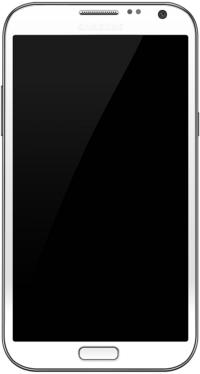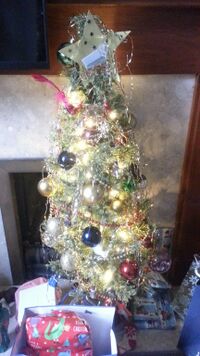Samsung Galaxy Note II LTE (samsung-t0lte)
 Galaxy Note II | |
| Manufacturer | Samsung |
|---|---|
| Name | Galaxy Note II LTE |
| Codename | samsung-t0lte |
| Released | 2012 |
| Type | handset |
| Hardware | |
| Chipset | Samsung Exynos 4412 Quad |
| CPU | Quad-core 1.6 GHz Cortex-A9 |
| GPU | Mali-400 MP4 |
| Display | 720x1280 AMOLED |
| Storage | 16/32/64 GB |
| Memory | 2 GB |
| Architecture | armv7 |
| Software | |
Original software The software and version the device was shipped with. |
Android 4.1.1 on Linux 3.0.31 |
Extended version The most recent supported version from the manufacturer. |
Android |
| postmarketOS | |
| Category | testing |
Mainline Instead of a Linux kernel fork, it is possible to run (Close to) Mainline. |
yes |
pmOS kernel The kernel version that runs on the device's port. |
6.10.0 |
| Device package |
|
| Kernel package |
|
Flashing Whether it is possible to flash the device with pmbootstrap flasher. |
Partial
|
|---|---|
USB Networking After connecting the device with USB to your PC, you can connect to it via telnet (initramfs) or SSH (booted system). |
Works
|
Battery Whether charging and battery level reporting work. |
Works
|
Screen Whether the display works; ideally with sleep mode and brightness control. |
Works
|
Touchscreen |
Works
|
| Multimedia | |
3D Acceleration |
Works
|
Audio Audio playback, microphone, headset and buttons. |
Partial
|
Camera |
Untested
|
| Connectivity | |
WiFi |
Works
|
Bluetooth |
Partial
|
GPS |
Untested
|
NFC Near Field Communication |
Untested
|
| Modem | |
Calls |
Untested
|
SMS |
Untested
|
Mobile data |
Untested
|
| Miscellaneous | |
FDE Full disk encryption and unlocking with unl0kr. |
Works
|
USB OTG USB On-The-Go or USB-C Role switching. |
Untested
|
| Sensors | |
Accelerometer Handles automatic screen rotation in many interfaces. |
Untested
|
Contributors
- Jack_Kekzoz
Users owning this device
- BlackEyedSquid (Notes: Verizon model (t0ltevzw), locked bootloader (KitKat update))
- Jack Kekzoz
How to enter flash mode
When the phone is powered off, press and hold down the , and buttons to turn it on in Download mode.
If you have installed a custom recovery, then when the phone is powered off, press and hold down the , and buttons to turn it on in Recovery mode.
Preparation
pmbootstrap init will prompt to choose a (near-mainline) kernel, which depends on the device display panel, see samsung-t03g display.
Installation
You can install postmarketOS either by flashing the rootfs to an sdcard, and then flashing the kernel using Heimdall when the phone is in Download mode, or you can install it via a recovery zip. It is not possible currently to flash rootfs in Download mode, as Heimdall has issues with flashing rootfs currently (see Heimdall). Please note that for the recovery installation, if you enable FDE, you need to ensure your custom recovery supports the cipher you are using.
Display
There is an issue with the display in that the brightness is too high when it turns on. Simply turning down the brightness, even a little, makes it jump to the correct setting.
FDE
FDE works ON OSK-SDL - not tested on unl0kr yet - although not with hardware acceleration.
Audio
Speaker and (main) mic work, but not headphone, as the kernel driver needs work to support that. In its current state the headphone audio is very crackly.
Bluetooth
Note: as of ~v24.06, only the non-free firmware package is available. The following is retained for informational purposes only.
Without the non-free firmware package, there may be some limited Bluetooth functionality [1]. If this occurs, it is probably because there is some code in the ROM of the BCM4334 chip. It is recommended to toggle Bluetooth off in this state, as the chip is designed to only work properly with the firmware patch, and unexpected issues may occur without it.
If you enable the non-free firmware package, then Bluetooth has partial functionality only:
- File sharing works (tested to and from a Motorola smartphone running stock Android 9)
- Keyboards work (though for some reason during pairing, the keyboard only became visible after it was paired with the smartphone.)
- Audio is NOT working properly, though that may be to do with a lack of configuration in Alsa UCM files.
- Internet sharing has not been tested.
In the long run, the Replicant project hopes to ask Cypress Semiconductor Corp. if they are willing to release the source code to the firmware under a permissive licence [2].
Touchkeys
The Back touchkey can be used for navigating back (mainly in Firefox, but also in other contexts). The Menu touchkey does nothing by default, but it can be assigned in the phosh settings.
If you wish, you can run this script in a terminal in the background to give you some haptic feedback and to illuminate the touchkey LEDs for 5 seconds when they are touched - you will need to install libinput-tools beforehand though. It is a bit of a hack, so won't be bundled in postmarketOS by default:
#!/bin/sh event_back='*KEY_BACK*' event_menu='*KEY_MENU*' event_power='*KEY_POWER*' event_home='*KEY_OK*' event_touchscreen='*TOUCH_DOWN*' libinput debug-events | while read line; do case $line in ($event_back|$event_menu) screen_state="$(cat /sys/class/drm/card1/card1-DSI-1/dpms)" case $screen_state='on' fbcli -E button-pressed echo 1 > /sys/class/leds/tm2-touchkey/brightness sleep 5 echo 0 > /sys/class/leds/tm2-touchkey/brightness esac ;; ($event_home) echo 1 > /sys/class/leds/tm2-touchkey/brightness sleep 5 echo 0 > /sys/class/leds/tm2-touchkey/brightness ;; ($event_power) screen_state="$(cat /sys/class/drm/card1/card1-DSI-1/dpms)" case $screen_state='off' echo 1 > /sys/class/leds/tm2-touchkey/brightness sleep 5 echo 0 > /sys/class/leds/tm2-touchkey/brightness esac ;; ($event_touchscreen) screen_state="$(cat /sys/class/drm/card1/card1-DSI-1/dpms)" case $screen_state='on' echo 1 > /sys/class/leds/tm2-touchkey/brightness sleep 5 echo 0 > /sys/class/leds/tm2-touchkey/brightness esac ;; esac done
Camera
Unfortunately, Megapixels 2.0 will now no longer work on devices with a Mali 400 GPU due to GTK 4.18 dropping the old GL renderer. The FlatPak version hasn't been updated yet, but when it is, it will cease to work.
Cheese works ok if you run the following command to set the pipeline, then use it in landscape orientation and in fullscreen mode:
media-ctl -d /dev/media0 -V '"S5C73M3":0 [fmt:VYUY8_2X8/1600x1200]' &&
media-ctl -d /dev/media0 -V '"s5p-mipi-csis.0":0 [fmt:VYUY8_2X8/1600x1200]' &&
media-ctl -d /dev/media0 -V '"s5p-mipi-csis.0":1 [fmt:VYUY8_2X8/1600x1200]' &&
media-ctl -d /dev/media0 -V '"FIMC.0":0 [fmt:VYUY8_2X8/1600x1200]'

Hardware
| Part | Name | Mainline kernel support | Notes |
|---|---|---|---|
| GPU | Mali-400 MP4 | Y | Driver |
| Panel | Samsung S6EVR02 / Magnachip EA8061 LCD panel | N | But they are in the exynos4-mainline repo 1 2. |
| Touchscreen | MMS152 | Y | Driver |
| WiFi | BCM4334 | Y | brcmfmac driver. Requires nonfree firmwares. |
| Bluetooth | BCM4334 | Y | Driver. Requires nonfree firmware. |
| GPS | MDM9615 | ||
| Modem | MDM9615 | N | This modem is also found in samsung-m3 (GT-i9305). |
| Fuel gauge | MAX17047 | Y | Driver |
| MFD | MAX77686 | Y | Driver |
| Audio codec | WM1811 | Y | Midas-specific driver. This driver is thought to be an upstreamed version of samsung-m0's downstream driver. t0 driver needs upstreaming for full audio functionality. Main driver |
| Front Camera | S5K6A3 | Y | Image sensor driver, Attached imaging processor driver. The FIMC-IS ISP does a lot of the heavy lifting for the sensor, which is why the sensor driver is small. Requires non-free firmwares. Currently has not been possible to load firmware and set the pipeline correctly. |
| Back Camera | S5C73M3 | Y | Driver. The sensor driver is lacking a section of code to enable full V4L2 compatibility. See this FIXME. Nevertheless, it is possible to take photos in Megapixels 2.0 and Cheese. |
| Flash LED & Vibrator (MFD) | MAX77693 | Y | Driver Device tree binding |
| Notification LED | AN30259A | Y | Driver Device tree binding |
| Accelerometer/Gyroscope | LSM330DLC | Y | Accelerometer driver, Gyroscope driver, Device tree binding. |
| Touchkey | Cypress ??? | Y | Driver |
| Magnetometer | AK8963C | Y | Driver, Device tree binding |
| Proximity/Light sensor | CM36651 | Y | Driver, Device tree binding |
| MHL | SII9244BO | Y? | This driver might work with samsung-m0 but not t0, or for both m0 and t0. Device tree binding |
| Sensor Hub | Samsung Sensor Hub | Y | Drivers, Device tree binding. This is required to get many sensors working. |
| Pressure Sensor | BMP182 | Y? | As reported by sensor-readout (f-droid) under android.
BMP180 (CONFIG_BMP280) Drivers, Device tree binding |
Partitions
Output of sudo parted /dev/mmcblk2 print:
Model: MMC MAG4FB (sd/mmc) Disk /dev/mmcblk2: 15.8GB Sector size (logical/physical): 512B/512B Partition Table: gpt Disk Flags:
| Number | Start | End | Size | File system | Name | Flags |
|---|---|---|---|---|---|---|
| 1 | 4194kB | 8389kB | 4194kB | BOTA0 | msftdata | |
| 2 | 8389kB | 12.6MB | 4194kB | BOTA1 | msftdata | |
| 3 | 12.6MB | 33.6MB | 21.0MB | ext4 | EFS | msftdata |
| 4 | 33.6MB | 37.7MB | 4194kB | m9kefs1 | msftdata | |
| 5 | 37.7MB | 41.9MB | 4194kB | m9kefs2 | msftdata | |
| 6 | 41.9MB | 46.1MB | 4194kB | m9kefs3 | msftdata | |
| 7 | 46.1MB | 54.5MB | 8389kB | PARAM | msftdata | |
| 8 | 54.5MB | 62.9MB | 8389kB | BOOT | msftdata | |
| 9 | 62.9MB | 71.3MB | 8389kB | RECOVERY | msftdata | |
| 10 | 71.3MB | 164MB | 92.3MB | fat16 | RADIO | msftdata |
| 11 | 164MB | 432MB | 268MB | ext4 | TOMBSTONES | msftdata |
| 12 | 432MB | 1866MB | 1434MB | ext4 | CACHE | msftdata |
| 13 | 1866MB | 4014MB | 2147MB | ext4 | SYSTEM | msftdata |
| 14 | 4014MB | 4601MB | 587MB | ext4 | HIDDEN | msftdata |
| 15 | 4601MB | 4610MB | 8389kB | OTA | msftdata | |
| 16 | 4610MB | 15.8GB | 11.1GB | ext4 | USERDATA | msftdata |
See also
- pmaports!2751 Preparatory merge request for LCD panel
- pmaports!2759 Initial device merge request
- pmaports!2913 Add partial audio support
- pmaports!2953 Add partial Bluetooth support
- pmaports!3012 Add camera flash/torch LED & notification LED support
- pmaports!3022 Add WiFi support
- pmaports!3062 Add vibration support
- pmaports!3192 Fix swapped touchkeys
 firmware-samsung-midas (Common board firmware for Exynos Note 2 and S3 devices)
firmware-samsung-midas (Common board firmware for Exynos Note 2 and S3 devices)- FCC's t0lteatt and t0ltetmo Schematics